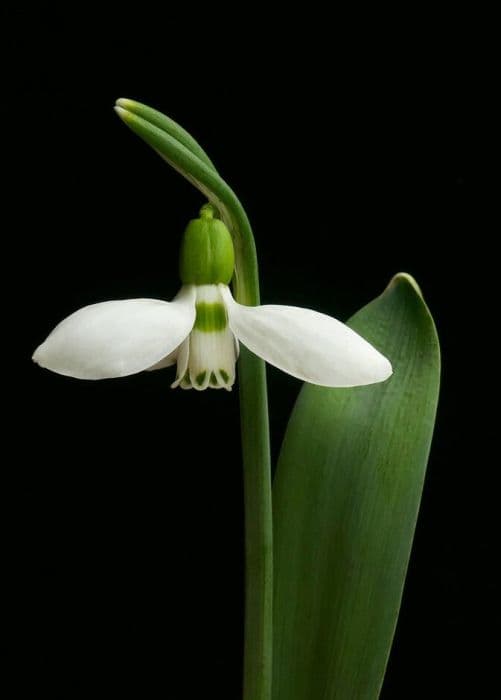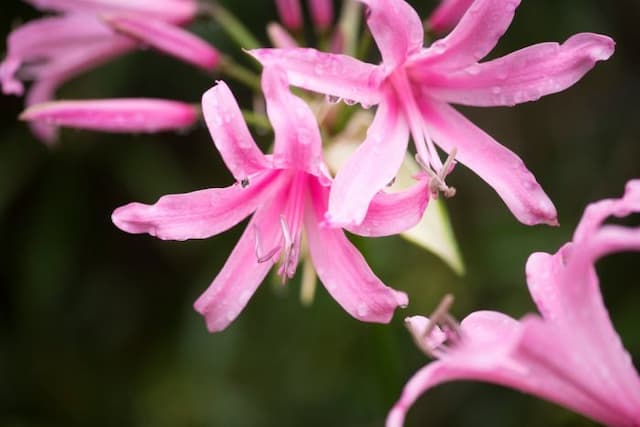Snowdrop Galanthus 'Ruby Baker'

ABOUT
The Galanthus 'Ruby Baker', more commonly known as a variety of snowdrop, is a charming plant renowned for its appealing appearance. It typically flowers early in the year, showcasing delicate white blooms that hang pendulously from their stalks. Each flower resembles a droplet, with outer petals that are pure white and shaped like elongated teardrops. These outer petals arch over the smaller inner petals, which often feature unique green markings that can vary in pattern. The foliage of the 'Ruby Baker' snowdrop is also noteworthy, consisting of slender, strappy leaves. These are a fresh, glaucous green hue that sprouts from the base, providing a contrasting backdrop to the bright white blooms. The overall aesthetic of the plant is one of simplicity and elegance, evoking a sense of the serene in the late winter to early spring garden when little else is in bloom. Its distinct appearance makes it a favorite among garden enthusiasts who value early-season flowers and wish to create a tapestry of early color in their garden spaces.
About this plant
 Names
NamesFamily
Amaryllidaceae
Synonyms
Snowdrop, Ruby Baker Snowdrop
Common names
Galanthus 'Ruby Baker'
 Toxicity
ToxicityTo humans
Snowdrops, including the variety Galanthus 'Ruby Baker', contain alkaloids that can be toxic to humans if ingested. The most common alkaloid present is galantamine, which can cause a variety of symptoms if a significant amount is consumed. Symptoms of snowdrop poisoning may include gastrointestinal disturbances such as nausea, vomiting, diarrhea, and abdominal pain. In some cases, more severe symptoms such as dizziness, confusion, and even convulsions could occur. Handling the plant may sometimes lead to skin irritations or allergic reactions in susceptible individuals.
To pets
Snowdrops, such as the Galanthus 'Ruby Baker' variety, are also toxic to pets including cats and dogs. The primary toxic components are the alkaloids, including galantamine, which can cause similar symptoms in pets as in humans. If a pet ingests any part of the snowdrop, they might experience vomiting, diarrhea, abdominal pain, and excessive drooling. Ingesting large quantities could lead to more severe symptoms such as seizures, lethargy, or changes in heart rate or blood pressure. It is important to seek veterinary care if you suspect your pet has consumed any part of the plant.
 Characteristics
CharacteristicsLife cycle
Perennials
Foliage type
Deciduous
Color of leaves
Green
Flower color
White
Height
6 inches (15 cm)
Spread
4 inches (10 cm)
Plant type
Bulb
Hardiness zones
3
Native area
Europe
Benefits
 General Benefits
General Benefits- Aesthetic Appeal - Adds visual interest to gardens with its delicate white flowers and striking green markings.
- Early Bloomer - One of the first flowers to bloom in late winter or early spring, signaling the end of the cold season.
- Attracts Pollinators - Provides an early source of nectar for bees and other pollinating insects when few other flowers are in bloom.
- Low Maintenance - Requires minimal care once established, making it a good choice for both novice and experienced gardeners.
- Drought Tolerant - Once established, it can tolerate periods of dry conditions, reducing the need for frequent watering.
- Naturalizing - Can spread over time to form natural drifts if the conditions are suitable, creating a carpet of blooms.
- Cold Hardy - Capable of surviving and thriving in cold winter temperatures, making it suitable for cooler climates.
- Versatility - Can be planted in a variety of settings including rock gardens, woodland gardens, borders, and beneath deciduous trees.
- Low Ground Cover - Helps to cover bare spots in gardens, providing a green cover throughout the year and flowers in the spring.
- Historical Interest - Holds a place in many traditional and historic gardens, offering a connection to the past through horticulture.
 Medical Properties
Medical PropertiesThis plant is not used for medical purposes.
 Air-purifying Qualities
Air-purifying QualitiesThis plant is not specifically known for air purifying qualities.
 Other Uses
Other Uses- Galanthus 'Ruby Baker' bulbs might serve as a natural pest deterrent due to their toxicity, specifically to deter rodent and deer activity in gardens.
- These flowers can be used in educational settings to teach botany students about bulb growth and development.
- Due to their early flowering, they can be studied for their impact on local ecosystems and as a biological indicator of climate change.
- They're sometimes used in photographic art for their beauty and as a symbol of the end of winter.
- In horticultural therapy, the planting and care of Galanthus 'Ruby Baker' may provide a soothing activity for individuals needing stress relief.
- Galanthus 'Ruby Baker' can be a valuable tool for beekeepers by providing an early source of pollen for honeybees.
- They can be integrated into wedding floral arrangements as a symbol of purity, hope, and the start of new beginnings.
- Because of its unique and appealing appearance, the plant can be used in the design of stamps, artwork, or as inspiration for patterns in fashion design.
- Cultivating these plants can contribute to conservation efforts, as Galanthus species are subject to illegal wild collection.
- Galanthus 'Ruby Baker' may be used in a sensory garden, their subtle fragrance and distinctive textures create an immersive experience.
Interesting Facts
 Feng Shui
Feng ShuiThe Snowdrop is not used in Feng Shui practice.
 Zodiac Sign Compitability
Zodiac Sign CompitabilityThe Snowdrop is not used in astrology practice.
 Plant Symbolism
Plant Symbolism- Hope: The Galanthus, commonly known as the "Snowdrop," often blooms in late winter while snow is still on the ground, thus symbolizing hope and the coming of spring.
- Purity: Snowdrops have pristine white petals, which are traditionally associated with cleanliness and innocence, hence they convey purity.
- Consolation or Comfort: Due to their propensity to appear during the tail end of winter, snowdrops are seen as a sign of comfort, reminding us that winter is almost over and warmer times are ahead.
- New Beginnings: As one of the first flowers to bloom as winter ends, snowdrops symbolize new beginnings and rebirth.
- Resilience: Despite their delicate appearance, snowdrops are hardy plants that can push through frozen ground, symbolizing resilience and the ability to persevere through hardships.
 Water
WaterSnowdrops, including the Galanthus 'Ruby Baker', should be watered thoroughly upon planting and during active growth if the soil begins to dry out. Generally, this might mean watering them once a week, with approximately 1 inch of water, depending on weather conditions. They require less water when dormant, so reduce watering after their foliage begins to die back in late spring. Snowdrops prefer a well-drained soil that remains moderately moist, but be cautious not to overwater as this can lead to bulb rot.
 Light
LightSnowdrops like Galanthus 'Ruby Baker' thrive best in partial shade, ideally under deciduous trees or shrubs that allow access to early spring sunlight before they leaf out. This lighting situation mimics their natural woodland habitat, where they benefit from the dappled sunlight.
 Temperature
TemperatureSnowdrops such as Galanthus 'Ruby Baker' are quite resilient and can withstand winter temperatures, typically surviving in conditions as low as -20 degrees Fahrenheit. The ideal temperature for growth is between 30 and 65 degrees Fahrenheit, which generally corresponds to late winter and early spring in many regions.
 Pruning
PruningPruning for Snowdrops, including Galanthus 'Ruby Baker', generally involves removing spent flowers and yellowing foliage. This should be done after the flowers have faded and leaves have died back naturally, usually in late spring. Snowdrops don't require regular pruning; just tidy up by removing dead or unsightly foliage.
 Cleaning
CleaningNot needed
 Soil
SoilThe Snowdrop 'Ruby Baker' prefers well-drained soil rich in organic matter, with a soil pH of 6.5 to 7.5. A mixture of loamy soil, peat, and perlite can create an ideal environment for its growth, providing both moisture retention and good drainage.
 Repotting
RepottingSnowdrops like 'Ruby Baker' generally do not require frequent repotting. They can be left undisturbed for several years and are typically repotted only when the clumps become overcrowded, which is roughly every 3-5 years.
 Humidity & Misting
Humidity & MistingSnowdrop 'Ruby Baker' thrives in outdoor conditions where it can receive natural humidity. It does not require any special humidity considerations when planted in the ground in its appropriate hardiness zones.
 Suitable locations
Suitable locationsIndoor
Place in bright, indirect light; keep soil lightly moist.
Outdoor
Plant in partial shade; ensure soil is moist and well-drained.
Hardiness zone
3-9 USDA
 Life cycle
Life cycleGalanthus 'Ruby Baker', commonly known as snowdrop, begins its life cycle with bulb germination, typically occurring in late winter or early spring as the soil starts to thaw. The plant emerges, showing slender, strap-shaped green leaves, and a flower stalk bearing a single, pendulous, bell-shaped white flower with distinctive ruby-red markings on its inner petals. This flowering phase is relatively brief, lasting a few weeks, during which pollination by insects must occur for seed production. Following flowering, the plant enters a period of vegetative growth where it stores energy in the bulb for the next season. As temperatures rise towards summer, the snowdrop's foliage dies back and the plant enters a period of dormancy, during which the bulb remains underground. In the next annual cycle, the bulb re-sprouts to repeat this process, continuing the plant's perennial growth cycle.
 Propogation
PropogationPropogation time
Early Spring
Propogation: The most popular method of propagating the Galanthus 'Ruby Baker', commonly known as the snowdrop, is by dividing its bulb clusters. This process is typically done while the plant is dormant, usually in late spring after the foliage has withered or in early fall before the growth of new shoots. Carefully dig up the bulbs, ensuring minimal disturbance to the roots, and gently separate the individual bulbs from the main clump. Each bulb should have a portion of the basal plate to ensure successful growth. Replant the bulbs immediately at the same depth they were previously growing, which is typically about 3 inches (approx. 7.6 cm) deep, and at a distance of about 3 to 4 inches apart (approx. 7.6 to 10 cm). Water the newly planted bulbs well to help them establish in their new location.









